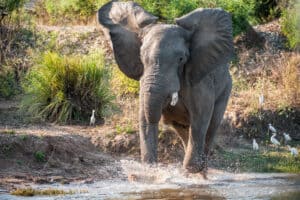Poaching has long been a threat to the African elephant population. During the Mozambique Civil War – a twenty year period between the 1970s and 1990s – elephant populations dropped 90% in Gorongosa National Park. Due to this hunt for ivory and merciless poaching for elephant tusks, the elephant population dropped to just 200 in the park in the early 2000s.
However, a new study out of Mozambique and focused on the Gorongosa National Park elephant populations illustrates the evolutionary effects of poaching. Now, more elephants are being born tuskless – a change that will impact the ecological landscape of Gorongosa National Park and the future of the species.
Though poaching is now illegal within Gorongosa National Park, its effects are evident in the elephant populations and the region and will remain so for years to come.
Tuskless Elephants
Before Mozambique’s Civil War only 18.5% of female elephants were tuskless. Now, after the birth of 91 females, that number has risen to 33%. After analyzing mathematical models of other evolutionary traits, researchers at Princeton University in New Jersey determined that the rise of tuskless offspring was directly related to the effects of poaching. Due to the selective killing of elephants for their ivory tusks, a larger fraction of genetically tuskless elephants in the region lived to reproduce compared to historical trends.
The change from tusked elephants to tuskless is an important one for a variety of reasons:
- First, only female elephants can be tuskless. The tuskless trait is actually a genetic mutation of the X chromosome and is therefore fatal in male elephants.
- Second, tusked and tuskless elephants consume different plants. With a higher number of tuskless elephants, the elephants’ changed diet will cause widespread ecologic impacts throughout the region. Elephants are a keystone species meaning their diet changes will have a trickle down effect on all of the other species in Gorongosa National Park.
- Third, due to only female elephants being able to survive without tusks, there will be an overall lower birth rate in the elephant populations. Without males, fewer babies will be born resulting in a slower species recovery rate than researchers originally hoped for.
Despite tusklessness being an advantage in the face of poaching and human’s warring over ivory, the impact it could have on the species is large. What seems like a good thing: the fast evolution to tusklessness to avoid being killed off by poachers could actually have negative long term effects.
Only one copy of the tuskless genetic mutation is needed to fatally affect a male baby elephant. As this gene becomes more dominant as a result of fast evolution, less male elephants will be born eventually causing the species to diminish even further than poaching originally did.
Fast Evolution
Humans dominate Earth’s ecological evolution. Elephants are not the only example. Humans have caused multiple animal species to experience “fast evolution”.
Due to higher amounts of human interactions in the state of South Dakota, rattlesnakes’ rattles have begun to shrink. This is due to the higher rates of death that occur in rattlesnakes when discovered by a human who hears their rattle.
Bighorn sheep’s horns are shrinking in Alberta, Canada. Due to trophy hunting in the area, sheep’s horns have dropped 20% in size.
Mice and bedbugs are becoming resistant to pesticides. Due to rodent control, these species have adapted new ways to survive exterminators. By evolving to become pesticide-resistant, mice and bedbugs are challenging human interference.
What we need to understand as humans is our impact on these other life forces. What we do, directly impacts the animals on our planet. Fast evolution won’t just affect elephants, bighorn sheep, mice, or rattlesnakes, eventually the impact of their adaptations will reach us. So, just maybe, we should look out for them now.
The photo featured at the top of this post is © iStock.com/StuPorts
Sources
- , Available here: https://www.npr.org/templates/story/story.php?storyId=216924322?storyId=216924322
- , Available here: https://www.science.org/doi/10.1126/science.abe7389
- , Available here: https://www.nature.com/articles/d41586-021-02867-y#ref-CR1
Thank you for reading! Have some feedback for us? Contact the AZ Animals editorial team.







